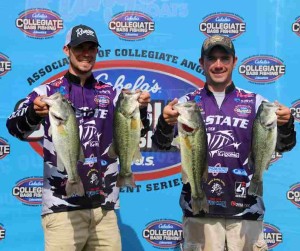By Garrett Cates
Pickwick Lake, Alabama – May, 2014
The Cabela’s Collegiate Bass Fishing Championship is one of the greatest competitions held for college level bass fishing. This year, there were 158 two-man teams competing from over one hundred different schools. Representing Kansas State University, my partner Graham Howard and I had high hopes of winning and hoisting the coveted crystal trophy.
As the spring semester began to wind down, my preparation and anticipation for the championship was at an all time high. I tracked the water temperature, current generation schedule, and Florence weather patterns for weeks leading up to the tournament. Pickwick Lake is known for its healthy fish populations and the giant trophy bass it produces.
Many techniques have proven themselves with large bags of fish this time of year. Some fish are still spawning and others are done, moving back to deep ledges for the summer. Punching or frogging the grass mats around Seven Mile Island, fishing the Wilson Dam tail water current and beating the hundreds of miles of bank have been productive for many. Based on my data however, I knew this year’s event would most likely be won with a post-spawn ledge bite and focused my studies on this situation. After scouring miles of the lake’s ledges and topography on my Navionics iPhone app, I found hundreds of spots I wanted to check during our three days of practice. These spots were all between 20-25 miles away from the take off ramp, but I felt they would be worth the long run.
Finally, school was over, the ten-hour drive was made, and it was time to hit the water! Our first day of practice was very promising. We caught many fish and lost a couple big ones in a spot we soon realized was our favorite. Fishing back into a creek, we noticed some of the fish were still on spawning beds. With the water temperature at 75 degrees and rising, this told me the fish were just finishing up spawning. Our strategy became catching them on their way back out to their post-spawn ledges, in front of main lake creeks and pockets. The ledges we targeted were shallower than what I had originally expected before arriving. They were dropping from anywhere between 6-10 feet, down to around 20-25 feet. Using solely a 5/8 oz. Jewel football head jig, these ledges were the most productive for us and held our bigger fish. Unfortunately, we only found one 200-yard stretch holding the size and numbers of fish we wanted. We needed to guard it from other competitors, and use our supply wisely to have enough fish for both days of the tournament.
With only one main spot and a handful of backups, we of course hit our main spot first. By first, I mean right when the current started generating around 9:30 AM. Current in these TVA (Tennessee Valley Authority) lakes trigger the ledge fish to get fired up and feed. Fishing a couple different banks in a boat ramp cove first thing in the morning, we hoped to run across a couple of insurance fish before moving deep. Getting some in the boat boosted our confidence and relieved some stress before heading to our ledge spot. As soon as 9:30 AM hit, we made our move, knowing the current was moving. Like clockwork, we pulled up and I caught our biggest fish of the tournament after just a few casts. Fishing the 200-yard stretch for a few hours we culled up to a decent limit of 16.25 pounds. We left the spot to save some for day two and search for even bigger fish. With no success, we ended up wasting over an hour saving the fish we had already caught from heat exhaustion in my live wells.
Unfortunately after doing everything we possibly could, one of our fish died, costing us a ½ pound penalty. The final weight was 15.75 pounds and put us in 29th place after the first day of the Championship. We headed back to the hotel, installed new aerator pumps in the live wells, ate some dinner, and got some sleep in preparation for day two.

Feeling content with day one and knowing we were in striking distance on day two, we wasted little time and went straight to our best spot with the intention of grinding out our whole day there. It took some time for the fish to become active, but they finally started biting. Our adrenaline was flowing and it was game time baby! Culling up by pounds and ounces at a time, we knew if we stuck with it all day. We could reach a decent sized bag of fish to move up in the standings. I lost a couple of good fish at the surface of the water, which would have given us a good bag in the 16-18 pound range. Heartbroken, we headed back to the weigh-in with a total of 12.06 pounds, giving us a two-day total of 27.81. Having been tournament fishing for years, I’m all too familiar with this scenario. Losing fish like the ones I lost is one of the worst feelings an angler can experience in such a big tournament. It’s one of those things that happens to everyone eventually and unfortunately it happened to us this time.
We were both pleased with our 38th place finish overall and are content in knowing that we had the fish to do better. It just wasn’t our time. We couldn’t have done it without the help of all our amazing sponsors including Costa Del Mar, Jewel Bait Company, Snack Daddy Lures, Shimano, G-Loomis, Dyna Tek, Trokar, Pur-Kleen and Phillips Fishing Products. We are looking forward to going back next year!

Liked this story? Subscribe here for more updates!

